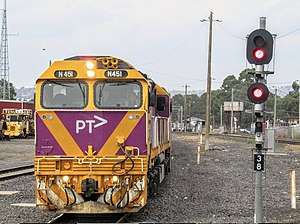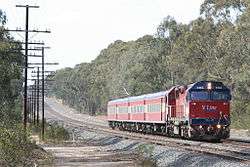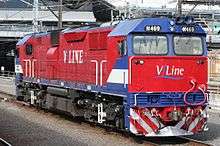V/Line N class
The N Class are a class of diesel locomotives built by Clyde Engineering, Somerton for V/Line between 1985 and 1987.
| V/Line N Class | |||||||||||||||||||||||||||||||
|---|---|---|---|---|---|---|---|---|---|---|---|---|---|---|---|---|---|---|---|---|---|---|---|---|---|---|---|---|---|---|---|
 V/Line N class arriving in Seymour | |||||||||||||||||||||||||||||||
| |||||||||||||||||||||||||||||||
| |||||||||||||||||||||||||||||||
| |||||||||||||||||||||||||||||||
| |||||||||||||||||||||||||||||||
History



By the start of the 1980s Victorian Railways passenger numbers had fallen to around 3 million per year, due to ageing rolling stock, stagnant timetables and competition from other forms of transport. The Lonie Report of 1980 recommended cuts to the network, with the general public responding by calling for the State Government to maintain a viable rail network. The government response in February 1981 was the New Deal for Country Passengers, a $115 million commitment to recast country rail passenger services in Victoria.[1]
As part of the New Deal all B class locomotives were to be re-built as the A class for use on passenger services and ten new locomotives ordered. Tenders closed in 1983 for the first 10 units, with Clyde Engineering being awarded the contract.[2] By mid-1985 the rising cost of the A class conversions saw the project abandoned after 11 locomotives were completed, and the N class order increased to 25 using the parts intended for the A class conversions.[1][3]
The class entered service on the 1,600 mm (5 ft 3 in) and operated on main lines all over the state, with the exception of the Gippsland line beyond Traralgon, a restriction that was later lifted. The class also saw regular use on The Overland Melbourne to Adelaide overnight service until it was withdrawn for conversion to 1,435 mm (4 ft 8 1⁄2 in) standard gauge in March 1995.[2] As well as being operated by V/Line, class members were hired to the Warrnambool line operator West Coast Railway from 1993 until its own locomotives became available in 1995,[4] and to Shepparton line operator Hoys Roadlines between 1993 and 2004.[5]
In preparation for privatisation the operations of V/Line Freight and V/Line Passenger were split in 1995,[6] with the N class allocated to the passenger operator and included in the sale to National Express in 1999.[7] Before this time the class had also been employed on freight services with a maximum speed of 90 km/h (56 mph).[2]
During the Regional Fast Rail project, a number of shutdowns were carried out to normal passenger services, with the N class being used to haul ballast trains on the Geelong line in 2003/04,[8] as well as being hired to Freight Australia in January 2004 to haul log and grain services.[9] Since 2007 class members have also been hired to heritage operator Seymour Railway Heritage Centre for use on its trains, as the provision of TPWS equipment permits running at full line speed over the Regional Fast Rail network.[10][11]
Today with the VLocity diesel multiple units having entered service, the N class play a lesser role, their main use being peak hour commuter services and InterCity services beyond the Regional Fast Rail network to Bairnsdale, Swan Hill and Warrnambool on the broad gauge and Albury on the standard gauge. The class are authorised to operate at 115 km/h (71 mph), but some units have been upgraded with D77/78 traction motors and have a maximum speed of 130 km/h (81 mph).[12] As of 1 June 2020, all engines had been fitted with the upgraded traction motors.[13]
Features
The N class feature a frame and body locally designed, but with imported Electro-Motive Division technology in the prime mover, generator and control unit, along with locally produced components such as the bogie frames by Bradken. The class was the first in the world to use the EMD D43 traction motor, similar to but smaller than that used in the C and G classes. Head end power is provided by a separate engine unit in a special compartment located at the number 1 end of the locomotive behind the electrical cabinet. The 240 kW generator provides 415 V 3-phase AC power for train lighting, air conditioning and other carriage requirements.[2]
Fitted with 6,800 litre fuel tanks the class were capable of running from Melbourne to Adelaide without refuelling.[14] Electrical and electronic components are modular to minimise delays after failures, and a reactive muffler system reduces the exhaust noise level. While most of them have only been used on broad gauge, three of them have been converted to 1,435 mm (4 ft 8 1⁄2 in) standard gauge by exchanging the wheelsets and repositioning the braking equipment.[2]
The narrow carbody provides for a catwalk along each side between the cabs, with fold back body panels for maintenance access. The cab is similar to that of the contemporary G class, with an anti-climber beam to prevent upward movement should a collision occur. Twin high impact windscreens are provided, with dual blade wipers. Each cab has room for a two-person crew, as well as an instructor if required. Air conditioning is provided, as well as an air-operated retention toilet at one end accessible from the catwalk. The locos were initially provided with automatic staff exchange equipment, but this was removed in the 1990s when the use of Electric Staff ended. The space remains in the cab side today.[2]
The carbody design was the basis of one-off locomotive GML10 built by Clyde Engineering in 1990.[15]
Compromise standard gauge wheel sets
To manufacture a compromise standard gauge wheel set one proceeds as follows: Take a raw Irish gauge length axle and machine the wheel seat at each end 82.5 mm (3.25 in) wider (or longer) along with all other machining required. The diameter of the wheel seat is slightly larger than the machined hole in the wheels in order to make for a press fit . The wheels are then pressed on at something like 20,000 psi (140,000 kPa) until they hit the raised shoulders and the wheels are now in the standard gauge position. The roller bearing seats are not modified so as to still suit the Irish gauge bogies.
Livery
The N class were delivered in the V/Line tangerine orange and grey livery, and progressively named after cities in Victoria, except for N453 which is named after the City of Albury on the other side of the Victorian/New South Wales border. The N class is, therefore, one of only three Australian locomotives where every class member is named.[16] N465 carries an earlier spelling of the city now Ballarat, originally Ballaarat. On 3 March 1987 locomotive N470 was returned to Clyde Engineering, Somerton for a ceremony, where brass plaques were affixed at both ends under the builder's plates, reading "N470 completing one million horsepower of diesel-electric locomotives built in Australia by Clyde Engineering Co".[17]
From 1995 the class members were repainted into a red and blue livery, with the V/Line logo on the side being altered after the privatisation of V/Line in 1999.[3] As of 2008, most N Class members have received white stripes along the cab-fronts, and cowcatchers painted yellow to increase visibility at level crossings in a program started in 2007.
In May 2008 locomotive N468 was repainted into the new V/Line livery of red with grey, white and yellow. Three of the repainted locos were converted to 1,435 mm (4 ft 8 1⁄2 in) standard gauge in 2011 following the conversion of the North East line.[18][19]
On 8 April 2017, N457 made its first revenue run to Albury in a new PTV livery of Purple and Yellow. This follows the painting of Set SN 8 into the new livery to match the V/Locity fleet and the wider fleet of Victorian trams and buses.
Locomotives
| Locomotive | Name | Serial no. | Traction Motors | Max Speed Km/h | Entered service | Owner | Gauge | Livery | Notes |
|---|---|---|---|---|---|---|---|---|---|
| N451 | City of Portland | 85-1219 | D77/78 | 130 | 20 September 1985 | V/Line Passenger | 1,600 mm (5 ft 3 in) broad gauge | Purple/Yellow 'PTV' | |
| N452 | City of Wodonga | 85-1220 | D43 | 115 | 10 October 1985 | V/Line Passenger | 1,600 mm (5 ft 3 in) broad gauge | Purple/Yellow 'PTV' | |
| N453 | City of Albury | 85-1221 | D77/78 | 130 | 1 November 1985 | V/Line Passenger | 1,435 mm (4 ft 8½ in) standard gauge | V/Line Mk3 | |
| N454 | City of Horsham | 85-1222 | D77/78 | 130 | 20 November 1985 | V/Line Passenger | 1,600 mm (5 ft 3 in) broad gauge | Purple/Yellow 'PTV' | |
| N455 | City of Swan Hill | 85-1223 | D77/78 | 130 | 19 December 1985 | V/Line Passenger | 1,600 mm (5 ft 3 in) broad gauge | Purple/Yellow 'PTV' | |
| N456 | City of Colac | 85-1224 | D43 | 115 | 29 January 1986 | V/Line Passenger | 1,600 mm (5 ft 3 in) broad gauge | Purple/Yellow 'PTV' | |
| N457 | City of Mildura | 85-1225 | D77/78 | 130 | 27 February 1986 | V/Line Passenger | 1,435 mm (4 ft 8½ in) standard gauge | Purple/Yellow 'PTV' | |
| N458 | City of Maryborough | 85-1226 | D77/78 | 130 | 17 March 1986 | V/Line Passenger | 1,600 mm (5 ft 3 in) broad gauge | Purple/Yellow 'PTV' | |
| N459 | City of Echuca | 85-1227 | D77/78 | 130 | 15 April 1986 | V/Line Passenger | 1,600 mm (5 ft 3 in) broad gauge | Purple/Yellow ’PTV’ | |
| N460 | City of Castlemaine | 85-1228 | D77/78 | 130 | 15 May 1986 | V/Line Passenger | 1,600 mm (5 ft 3 in) broad gauge | V/Line Mk3 | |
| N461 | City of Ararat | 85-1190 | D43 | 115 | 25 July 1986 | V/Line Passenger | 1,600 mm (5 ft 3 in) broad gauge | Purple/Yellow 'PTV' | |
| N462 | City of Shepparton | 86-1191 | D43 | 115 | 14 August 1986 | V/Line Passenger | 1,600 mm (5 ft 3 in) broad gauge | Purple/Yellow 'PTV' | |
| N463 | City of Bendigo | 86-1192 | D77/78 | 130 | 4 September 1986 | V/Line Passenger | 1,600 mm (5 ft 3 in) broad gauge | Purple/Yellow 'PTV' | |
| N464 | City of Geelong | 86-1193 | D77/78 | 130 | 29 September 1986 | V/Line Passenger | 1,435 mm (4 ft 8½ in) standard gauge | Purple/Yellow ‘PTV’ | |
| N465 | City of Ballarat | 86-1194 | D77/78 | 130 | 20 October 1986 | V/Line Passenger | 1,600 mm (5 ft 3 in) broad gauge | V/Line Mk3 | |
| N466 | City of Warrnambool | 86-1195 | D43 | 115 | 31 October 1986 | V/Line Passenger | 1,600 mm (5 ft 3 in) broad gauge | Purple/Yellow 'PTV' | |
| N467 | City of Stawell | 86-1196 | D77/78 | 130 | 26 November 1986 | V/Line Passenger | 1,600 mm (5 ft 3 in) broad gauge | Purple/Yellow 'PTV' | |
| N468 | City of Bairnsdale | 86-1197 | D77/78 | 130 | 19 December 1986 | V/Line Passenger | 1,600 mm (5 ft 3 in) broad gauge | V/Line Mk3 | |
| N469 | City of Morwell | 86-1198 | D77/78 | 130 | 29 January 1987 | V/Line Passenger | 1,600 mm (5 ft 3 in) Broad gauge | V/Line Mk3 | |
| N470 | City of Wangaratta | 86-1199 | D77/78 | 130 | 17 February 1987 | V/Line Passenger | 1,600 mm (5 ft 3 in) Broad Gauge | V/Line Mk3 | |
| N471 | City of Benalla | 87-1200 | D77/78 | 130 | 28 February 1987 | V/Line Passenger | 1,600 mm (5 ft 3 in) broad gauge | V/Line Mk3 | |
| N472 | City of Sale | 87-1201 | D77/78 | 130 | 27 March 1987 | V/Line Passenger | 1,600 mm (5 ft 3 in) broad gauge | V/Line Mk3 | |
| N473 | City of Warragul | 87-1202 | D77/78 | 130 | 28 April 1987 | V/Line Passenger | 1,600 mm (5 ft 3 in) broad gauge | Purple/Yellow 'PTV' | |
| N474 | City of Traralgon | 87-1203 | D77/78 | 130 | 28 May 1987 | V/Line Passenger | 1,435 mm (4 ft 8½ in) standard gauge | V/Line Mk3 | |
| N475 | City of Moe | 87-1204 | D77/78 | 130 | 6 July 1987 | V/Line Passenger | 1,600 mm (5 ft 3 in) broad gauge | Purple/Yellow 'PTV' |
References
- Scott Martin & Chris Banger (October 2006). "'New Deal' for County Passengers - 25 years on". Newsrail. Australian Railway Historical Society (Victorian Division). p. 318.
- Sid Brown (September 1987). "V/Line's N Class Locos". Newsrail. Australian Railway Historical Society (Victorian Division). pp. 268–269.
- N class diesel electric locomotives Mark Bau's VR website
- Peter Attenborough (February 2004). "West Coast Railway". Australian Model Railway Magazine. pp. 32–34.
- Sid Brown (April 1996). "Train A-Hoy". Newsrail. Australian Railway Historical Society (Victorian Division).
- "News". Newsrail. Australian Railway Historical Society (Victorian Division). November 2005.
- Peter Attenborough (June 2006). "V/Line Passenger". Australian Model Railway Magazine. pp. 26–29.
- "Vivsig - Geelong Line -Regional Fast Rail". Vicsig. Retrieved 17 November 2008.
- Trains in Victoria Volume 5 (DVD)
- "SRHC Blue Train - Seymour to Camperdown". Seymour Railway Heritage Centre. Retrieved 17 November 2008.
- "Miscellaneous VIC sightings (Steamrail Bendigo Cup charter)". Railpage Australia Forums (Victoria). www.railpage.com.au. 12 November 2008. Retrieved 17 November 2008.
- "Network Service Plan - Addenda" (PDF). V/Line ~ Network Access Information Pack. www.vline.com.au. 23 May 2008. Archived from the original (PDF) on 21 July 2008. Retrieved 17 November 2008.
- Weekly Operational Notice 36/2017 p.29
- Railmac Publications (1992). Australian Fleetbooks: V/Line locomotives. Kitchner Press. ISBN 0-949817-76-7.
- Oberg, Leon (2007). Locomotives of Australia: 1850s - 2007. Rosenberg Publishing. p. 411. ISBN 1877058548.
- Cable, David (2015). Rails Across Australia: A Journey Through the Continent. Pen and Sword. ISBN 9781473844377. Retrieved 7 December 2017.
- "Rollingstock". Newsrail. Australian Railway Historical Society (Victorian Division). June 1987. p. 181.
- N Class Railpage
- N Class Vicsig
External links
![]()